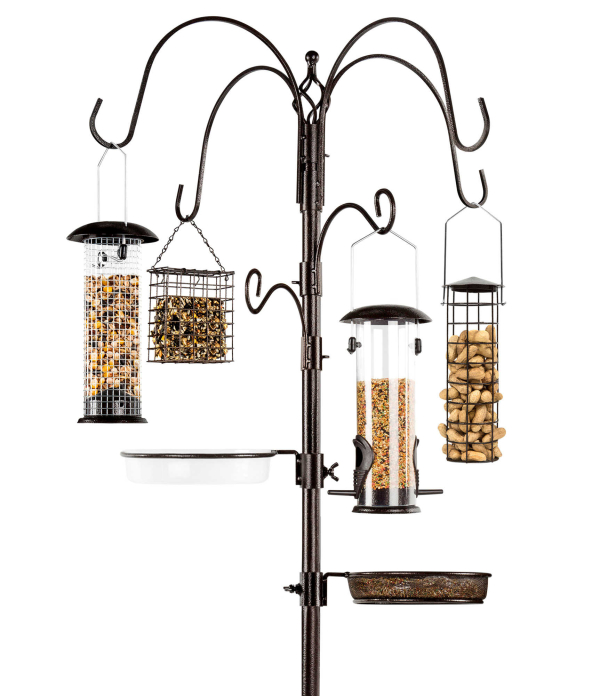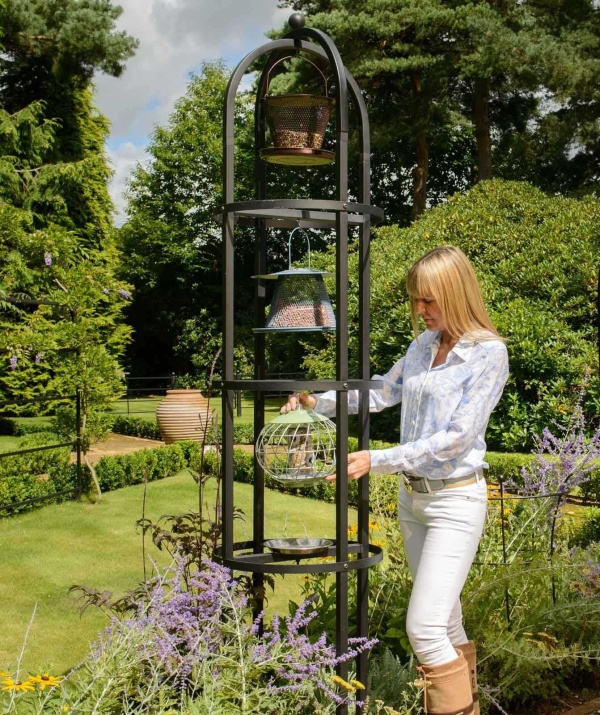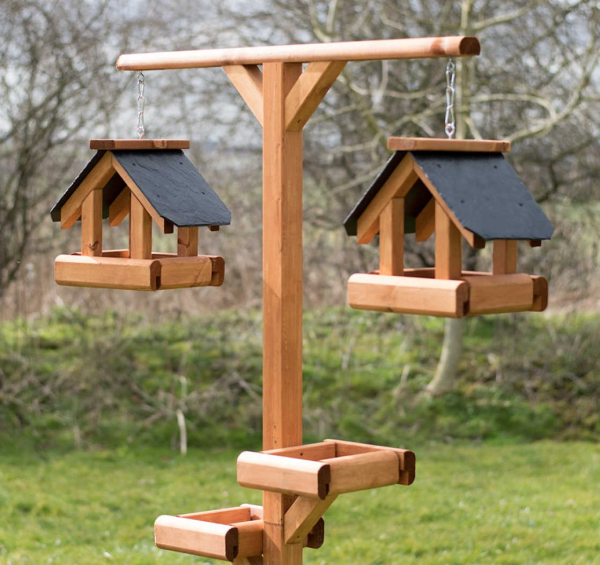
A sharp-looking feeding station that offers a diversity of bird foods is the centerpiece for any backyard birding project, but there are a variety of elements that when combined will attract and benefit a greater variety of birds.

Surrounded by a beautifully landscaped yard that provides attractive habitat, a decorative feeding station is a big plus for birds and birders to enjoy.

Tie your feeding station options together with your birdscaping plans for a Big Package approach to your yard. Some birders may even design their own feeding station using simple woodworking skills.
|
With the changing of the seasons it’s a good time to reflect on your yard, feeding station, and water feature to consider what worked well this year, and what didn’t. Consider your yard’s landscaping including flower gardens, shrubs, trees, snags, rocks, and nest boxes; plus your feeders, bird foods, watering options – and more. Ideally, you want to complement your yard so it is attractive for you, while providing a variety of attractions and benefits for birds, especially the birds you enjoy seeing the most season to season.
First, clear your mind; now consider your yard as a blank slate. What elements would you like to add, remove, plant, prune, clear, and enhance – from your landscaping prospective, and from a birdscaping angle.
Sometimes it’s easiest to use a checklist. What’s there? What’s missing? How can you improve any elements?
Landscaping
flower gardens
grasses
lawn
shrubs
vines
trees
snags
rocks
Birdscaping
water features
feeders
bird foods
nest boxes
Landscaping & Birdscaping
Any big trees in your yard are like gold, for beauty, shade, and for attracting birds. Then think about vertical levels below the trees, including shrubs, vines, tall grass, flowering plants, and lawn. How is your yard laid out to provide a variety of elevations of plants, each accenting the next. We always try to avoid straight lines of plants, preferring circles, ovals, semicircles over squares and rectangles that are often used by tradition; in short, think outside the box.
When considering new plantings, native plants always grow best in your area, and local and migrating birds have adapted to these plants, including trees, over centuries and millennia. Emphasize planting nectar-producing flowering plants, especially red, orange, and yellow tubular flowers for hummingbirds and orioles, along with seed producing flowering plants such as coneflowers, sunflowers, and many others.
Overall, when considering birdscaping, think about providing a variety of cover and open areas, shade and sunny spots, thick cover and open cover, keep some dead branches and snags when possible for woodpeckers, creepers, and nuthatches. Consider winter cover as well as summer cover; consider a mix of deciduous trees and conifers, new plants with old established growth – be creative.
Bird Baths & Other Water Features
Consider more than one water feature – bird baths can add a lot to any yard for birds, and they can be a decorative element if you choose a colored ceramic bird bath for example. Then too, you can add another dimension to a bird bath quite simply by adding a dripper, mister, or mini-fountain, plus each of these options provide the sound of water, soothing for you and attractive for birds. Soon, in northern latitudes a heated bird bath will become especially important and will help you see and attract a greater variety of wintering birds, and winter water will also benefit birds in a big way.
An option to a bird bath, or a second addition, is to add a hanging waterer – similar looking to a feeder but with water rather than seeds – more similar to a large nectar feeder for hummingbirds. Some hanging waterers are more decorative than others, but some people like to keep things simple or less obvious too.
At the top of many birders’ water lists are decorative water features, including a stylish fountain, a natural rock waterfall, a recirculating water wall of dripping water, and more. You may want to try a do-it-yourself water feature, or you can pick out a favorite from a landscaping company or mega-hardware store. And keep in mind that you can add some natural elements to a store-bought water feature in the form of rocks, wood, or plants, especially in the area surrounding it.
Feeders
The most obvious backyard birding equipment are bird feeders. Is it time to improve your feeding station – either by additions to your existing feeders, or by replacing damaged, old, or unattractive feeders? Perhaps you’re thinking of using a single color theme rather than a hodge-podge of feeder colors. There are lots of options to look into – do a little shopping, see what attracts your attention, and enjoy the chance to improve and update your existing feeding station with the coming winter season in mind.
Every winter feeding station should have basic elements for seed-eating birds that may include one or all of the following options: A tube feeder, hopper feeder, platform feeder, and a combination feeder. Of course, you can have more than 1 of any of these feeder types; and you can choose simple feeders, colored feeders, themed feeders – large or small.
Then too, there are always suet feeders, which should be a standard part of any feeding station. And in some locations in Sunbelt states, some birders are lucky enough to attract hummingbirds year-round, so a nectar feeder becomes an important part of their feeding station.
Feeding Options
Seed options include black-oil sunflower seeds, sunflower chips, nyjer thistle, and safflower seeds are best – plus peanuts and other nut chips. (Avoid milo and cracked corn, which are common in cheap seed mixes.) Some people prefer to offer seed mixes, others prefer to provide a single seed type per feeder. Obviously, you need a separate feeder for thistle seeds, which don’t mix well with other seed types.
Shelled black-oil sunflower seed and shelled peanuts become more popular with birders every year, and the no-shell option provides a much cleaner area surrounding your seed feeders. Shelled seeds might cost a bit more, but you’re not paying for the shells, and you won’t need to clean shells from beneath your feeders.
Providing sugar-water nectar for hummingbirds can be a year-round option for some Sunbelt birders, and you may also attract different wintering birds by offering cut fruits or grape jelly, but that’s pretty much a neighborhood by neighborhood option that may or may not be utilized by birds in the area, but it’s always worth a try.
Nest Boxes
In the absence of natural or woodpecker-excavated cavities, consider adding a couple different sizes of nest boxes to your yard too – small bird houses for chickadees and wrens, larger ones for screech owls, and if you have a larger property a couple bluebird nest boxes can be very rewarding, as are larger nest boxess for Wood Ducks, Barn Owls, Barred Owls – and more.
Keep in mind too, that nest boxes double as roosting sites during fall and winter for chickadees, bluebirds, and owls, so if you add a nest box now, you may attract winter visitors and provide needed shelter for cavity nesting birds – while being prepared in advance for the spring nesting season.
That’s a big look at The Big Backyard Package! Whether you are the best landscaper or not so good, there are always ways to improve your yard to attract and benefit a variety of birds – and that’s true for feeding stations and water features too. Give it some thought, give it some muscle power, and spend a little cash to improve Your Big Package as migration continues and wintering birds arrive. Best of Luck!
Share your backyard birding experiences and photos at editorstbw2@gmail.com